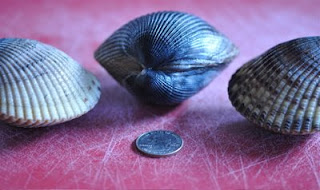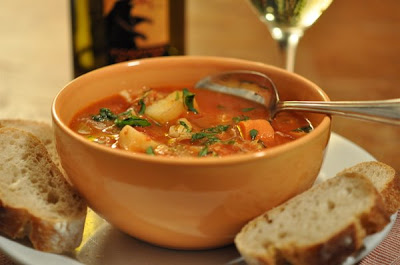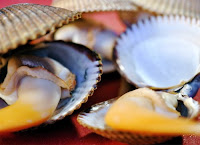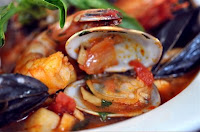 I’ll admit that among most clam chowder aficionados—of which I am most certainly one—Manhattan style is something of a red-haired step child. Given my druthers, I go for cream and butter too. But let’s not sell short that versatile fruit the tomato. It’s among the New World’s most successful exports, along with cocoa, potatoes, and corn. In any other chowder most of us love the tomato, but for some reason it’s maligned when in company with clams.
I’ll admit that among most clam chowder aficionados—of which I am most certainly one—Manhattan style is something of a red-haired step child. Given my druthers, I go for cream and butter too. But let’s not sell short that versatile fruit the tomato. It’s among the New World’s most successful exports, along with cocoa, potatoes, and corn. In any other chowder most of us love the tomato, but for some reason it’s maligned when in company with clams.
Well, get over it. While Manhattan Clam Chowder may often be dismissed as nothing more than vegetable soup with a few clams tossed in for good measure, if you cook it at home it can be so much more. And if you make it with cockles instead of clams…well, then you’re in truly rarified territory.
About Cockles
 Cockles are medium-sized bivalves that inhabit sandy beaches and mudflats in the intertidal zone. Because their siphons are so short, they’re usually buried just beneath the surface. They can be distinguished from other bivalves by radiating ridges on the shell that run from hinge to margin.
Cockles are medium-sized bivalves that inhabit sandy beaches and mudflats in the intertidal zone. Because their siphons are so short, they’re usually buried just beneath the surface. They can be distinguished from other bivalves by radiating ridges on the shell that run from hinge to margin.
I’ve had good cockling in Oregon. Puget Sound cockles (Clinocardium nuttalli), though widespread, aren’t commonly encountered, probably because of a lack of sandy habitat. When I saw a bunch of broken cockle shells littering a Hood Canal beach the other day I knew right away we were going to sacrifice a limit of steamer clams for these beautiful-looking mollusks. The easiest way to harvest them is with a garden rake. Look for tideflats with evidence of cockle shells, then rake the flats at low tide. It doesn’t take an abundance of elbow grease to uncover a cockle—you’ll know right away because the rake tines will ping off the shell.

Cockles have a muscular foot that can reportedly propel them up to two feet as they “jump” along the sea floor. Most folks don’t bother with cockles because they’re tough and also because they’re usually filled with grit from their sandy habitat. But they’re meaty, flavorful, and fun to forage. You can get rid of the grit by keeping the cockles in clean salt water for 24 hours before cooking, and the toughness is remedied by chopping and tenderizing. I use them mostly for chowder.
Spicy Manhattan Cockle Chowder

A few days before the new year my neighbor stopped by with a bagful of peppers from his garden. Seattle is not an easy place to grow peppers—and how these things were still in mint condition in the middle of winter was something of a mystery. But I’m fine with mysteries, especially if they work their way into a variety of deep winter cooking to add spice and intrigue. We dropped a few into the New Year’s Eve Paella and sprinkled a generous helping into another Crab and Seafood Gumbo. The last got tossed in the Manhattan Cockle Chowder.
This is the sort of dish you can cook as you process each ingredient, an hour from start to finish. The hot peppers spice it up and the sherry gives it a sweet finish.
20 medium-sized cockles in the shell (or 2 cups of meat)
1/2 cup white wine
1/2 cup water
2 tbsp olive oil
3 thick slices bacon, diced
1 large onion, sliced into half-moons
2 cloves garlic, minced
3 carrots, sliced into rounds
3 ribs celery, split and sliced
2 hot peppers, diced
3 large red potatoes, peeled and cubed
2 28 oz cans whole plum tomatoes, with juice
2 tbsp fresh thyme, chopped
2 tbsp fresh parsley, chopped
sherry
parsley for garnish
1. With live cockles in the shell, figure you’ll need about 20, or more if they’re small (about 2-3 pounds). Combine wine and water in a heavy pot and heat on high. Add cockles when boiling, cover, and steam for several minutes until all shells are open. Turn off heat, remove meat to a bowl, and strain liquid (yields about 2 cups).
2. In same pot, heat oil and saute bacon until beginning to crisp. In turn, stir in onions, garlic, carrots, celery, peppers, and potatoes, adding each ingredient successively as you finish chopping.
3. Add reserved cockle broth. Pour in both cans of tomatoes and, to save time and mess, rough-cut tomatoes in the pot with a spoon or knife. Bring to a boil, then reduce heat to simmer. Add herbs. Cook until vegetables begin to soften, then add chopped cockles. Cook several more minutes. Ladle into bowls, add sherry to taste, and garnish with chopped parsley. Serve with crusty bread.
Like this:
Like Loading...
 LAKSA IS THOUGHT to be the centuries-old creation of Chinese traders living in Malaysia. The country has long been a crossroads for a variety of Asian cultures. Ethnic Malays, Chinese, and Indians make up the bulk of the population, and their cuisines intermingle to give Malaysia a wide-ranging national menu.
LAKSA IS THOUGHT to be the centuries-old creation of Chinese traders living in Malaysia. The country has long been a crossroads for a variety of Asian cultures. Ethnic Malays, Chinese, and Indians make up the bulk of the population, and their cuisines intermingle to give Malaysia a wide-ranging national menu.  Years ago I tried a bowl of Laksa while on a 24-hour layover in Singapore. I rediscovered it recently while contemplating a haul of cockles, a traditional ingredient in Laksa.
Years ago I tried a bowl of Laksa while on a 24-hour layover in Singapore. I rediscovered it recently while contemplating a haul of cockles, a traditional ingredient in Laksa. 3 shallots, peeled
3 shallots, peeled





































